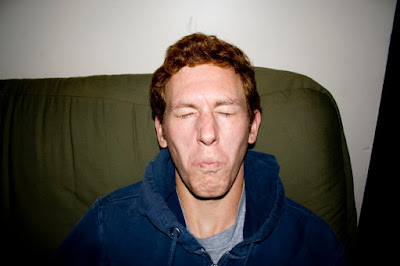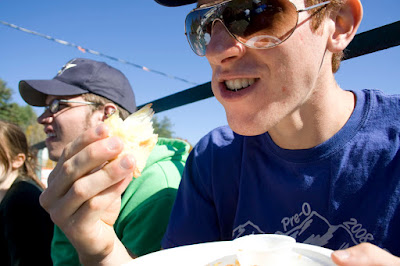Turnley proposes a way in which war photography should be approached, on the eve of the new gulf war. He notes that it is capturing "the realities of war" that is essential. As I scrolled through his work, though I found it moving, I did not find it different from any other documented photographs on wars that were either published in books, but mostly on media sites. I think it's interesting to note the similarities I found with pictures published on cnn.com and Time magazine, and the pictures on Turnley's site. Though, it is important to note that he does raise important points in experiencing a sort of empathy (obviously, I don't think one can really experience complete empathy in a situation like this) when looking at war photographs, to know that it is not necessarily about patriotism and courage (though it is that too).
The one thing I thought was interesting was when he stated 'war is a necessary evil.' He repeatedly notes and talks about how he captures the 'evil' part, but never the necessity factor. I am confused by the (somewhat) contradictions with this statement and his photographs.
Furthermore, the timing is also important to note. Obviously, he has strong feelings, writing this letter on the brink of another war. This is the time when people and media might think that war is "convenient". Yet, I don't think that the same sentiments hold true 5 years later, with the knowledge and media that we hold now, and I think that would be a fascinating juxtaposition.
Tuesday, October 28, 2008
Sunday, October 26, 2008
Saturday, October 25, 2008
Response to Lomography
When I discovered lomography, I thought - that's how I want my world to be seen. I loved the colours and the vibrancy and the pace that the pictures provoked. So, it was a no-brainer in what I wanted to talk about for my gleaning. However, I also wanted to tap into the minds of people who, you know, hated lomography, like Alfred. I had very rarely met someone who disliked lomography, and it is very interesting to see why they don't.
I think the main questions I thought about is...what place does experimental photography have in art? Does the "don't think, just shoot" concept stray away from an artist's point of view? Or is lomography for people who just want to have fun? Yet, is that okay for them to publish books and have exhibits and call it art? We talked earlier in the semester about how an artist cannot be judged by one photograph, they should be judged by their array of work. So, does this come in the same way with lomography, if the photographs are supposed to be 'accidental', there isn't really a point in taking the photograph? Or is the point in achieving a sort of colourful, vibrant image? And if so, what does that mean?
Wednesday, October 22, 2008
Response to "The True Meaning of Pictures"
"The True Meaning of Pictures" by Jennifer Baichwal shows appalachia "the holler dwellers" through the work of Shelby Lee Adams. It was an incredibly interesting film, but not necessarily about the people who live in Appalachia, rather the stereotypes and the biases evident in the film. It's interesting to ask the question, "who has the right to film a documentary?" Adams has the excuse that he grew up in Appalachia, but noting that he would switch accents when he was around the 'holler dwellers' and when he was doing interviews in front of the camera perhaps implies that there is a conflict in identity. Or is he just trying to please the crowd? Trying to fit in?
I'm sure that there were tons of biases in the film, but it's also important to note the photography with the girl hugging a torn down wooden window in a decapitated looking house and the reactions by Shelby Lee Adams and the woman who had left Appalachia and how different their analysis were. This is because they were both seemingly from the same background, yet conceived the photograph in two different ways. The essential thing to note about this scene though, unlike the biases from other parts of the film that Adams shows, is that when looking at a piece of art, it is open to different interpretations. So, though it seems as if they were both from the same background, they could have come out with different experiences from their backgrounds and felt differently about Appalachia, and I think that is important to consider.
Sunday, October 19, 2008
Response to Errol Morris' Photography as a Weapon
Found here: http://morris.blogs.nytimes.com/2008/08/11/photography-as-a-weapon/?scp=3&sq=photography&st=cse
Errol Morris interviews Hany Farid, an expert on digital photography and photography fraud, and Charles Johnson, of little green footballs.
A question that I wondered the whole time I read this article, and which was echoed by a commenter on the article, was that isn't each photographer essentially altering a photograph by taking it? I suppose one could argue that by what angle the photographer is taking the photo in, how focused they want the picture to be, and what is being taken is a form of manipulation. One could also argue that it is art, showing the artist's point of view. So, when does it become art and when is it altered reality? Is it more so with photoshop? Does simply changing the format change what we see?
I found Hany Farid's comments on the brain's acceptance of the visual and language most interesting. It's important to understand that our eyes accept a lot of truth, maybe because we are used to it. Visual = truth; Language (i.e. gossip) = faith. The idea that "seeing is believing" has penetrated what we understand as truth. It's also fascinating to see that humans are able to believe things that are concrete (i.e. bones, ancient remains, etc). Perhaps the idea "seeing is believing" will witness a more negative turn now that technology is able to manipulate our eyes? Maybe by understanding that most things in the media are doctored will help us to understand that we can't take things on face value. It means doing more work, more research, more skepticism in a world where things are becoming more convenient and accessible and humans are getting lazier.
Errol Morris interviews Hany Farid, an expert on digital photography and photography fraud, and Charles Johnson, of little green footballs.
A question that I wondered the whole time I read this article, and which was echoed by a commenter on the article, was that isn't each photographer essentially altering a photograph by taking it? I suppose one could argue that by what angle the photographer is taking the photo in, how focused they want the picture to be, and what is being taken is a form of manipulation. One could also argue that it is art, showing the artist's point of view. So, when does it become art and when is it altered reality? Is it more so with photoshop? Does simply changing the format change what we see?
I found Hany Farid's comments on the brain's acceptance of the visual and language most interesting. It's important to understand that our eyes accept a lot of truth, maybe because we are used to it. Visual = truth; Language (i.e. gossip) = faith. The idea that "seeing is believing" has penetrated what we understand as truth. It's also fascinating to see that humans are able to believe things that are concrete (i.e. bones, ancient remains, etc). Perhaps the idea "seeing is believing" will witness a more negative turn now that technology is able to manipulate our eyes? Maybe by understanding that most things in the media are doctored will help us to understand that we can't take things on face value. It means doing more work, more research, more skepticism in a world where things are becoming more convenient and accessible and humans are getting lazier.
Thursday, October 16, 2008
Landscapes Response
When Jennifer Baichwal brought up the question of whether we had any difficulty being "cliché" in our landscapes assignment, I begun to think what I did, and if I had thought of the cliché factor before I shot. Whenever I think about landscapes, I think about how much I don't like shooting it. But then, we were given an extremely relaxed approach to it which made me feel better about it. It was interesting, because even though I thought my photographs were cliché, the concept behind it might not be. I think one can shoot the same thing like another photographer did (not exactly the same, but perhaps the same subject), but it might not be redundant because of what your goal was behind the photographs.
I think it's very easy to write off the photographs before knowing what the photographer's aim was behind it. And it's interesting because as I sat there, I realised that though the photographs might look cliché, the meaning behind it was not. This is why I liked doing the pecha kucha's, because I felt like everybody had something to say that might not be obvious. It was even more interesting to hear the critiques, because meaning that was derived from others seemingly formed the photograph.
All in all, I enjoyed shooting what I shot. I think if viewers were to look at it, without any explanation, would seem to be redundant, but the concept or idea behind it is sometimes more important. And I think that is crucial, especially in landscape photography, when most would shoot things that are not exactly detail oriented. It's easier to look at something focused and derive meaning because you are essentially seeing the artist's point of view (it's so focused that it has to be that!) But with something vague, meaning can be lost in the big picture and that might be why I have always struggled with understanding landscape photography.
Subscribe to:
Comments (Atom)



















































